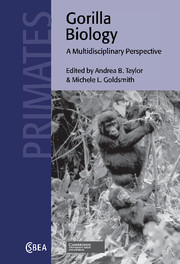Book contents
Afterword
Published online by Cambridge University Press: 11 August 2009
Summary
Once, in the Central African Republic, a BaAka pygmy working with one of us (MLG) left a “precious” pack of matches on a log near a nesting site. “Wanga, you left your matches behind.” His response, “The gorillas have been without fire for too long – it is not fair.” The human-like quality of gorillas is one reason we are compelled to study them. By examining all aspects of their biology, we begin to understand them and, in so doing, gain insight into ourselves.
In this multidisciplinary approach to gorilla biology, the contributing authors have advanced our knowledge of these apes. Some have yielded novel insights, while others have provided greater clarity with more detailed and comprehensive analyses. Yet, with each insight, additional questions are generated, and challenges remain.
As has been pointed out by several contributors, though the use of molecular genetics to address questions of phylogeny and taxonomy is not new, we are still in the formative stages in terms of our ability to interpret genetic variation from molecular data and draw biologically meaningful distinctions. This is reflected in the fact that debates over gorilla taxonomy, as presented both here and elsewhere, center at least as much on methods as on findings. One need only compare the results and interpretations of molecular studies that rely on different (and sometimes even identical!) genetic markers to see that this is so.
Which genetic markers are phylogenetically informative? What sample sizes are needed to achieve reliable results?
- Type
- Chapter
- Information
- Gorilla BiologyA Multidisciplinary Perspective, pp. 498 - 500Publisher: Cambridge University PressPrint publication year: 2002

